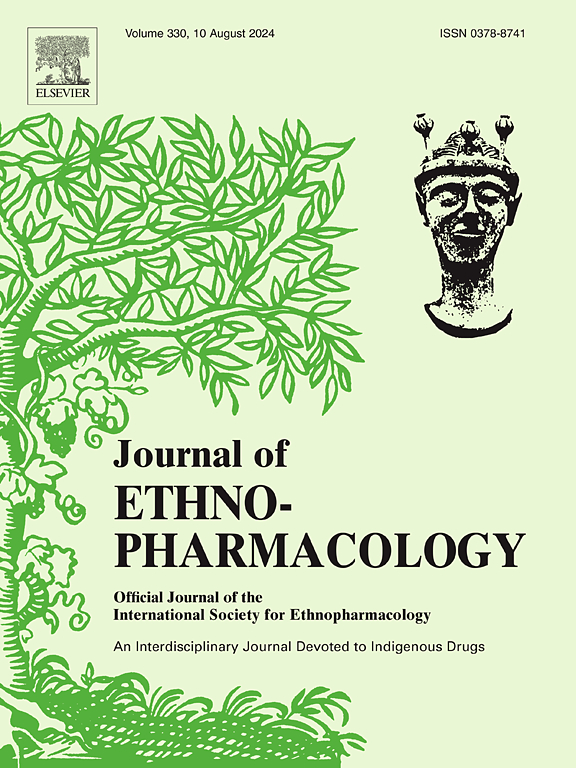Thesium chinense Turcz. and its compound astragalin alleviate lipopolysaccharide-induced acute lung injury via the PI3K/AKT/p53 signaling pathway
IF 4.8
2区 医学
Q1 CHEMISTRY, MEDICINAL
引用次数: 0
Abstract
Ethnopharmacological relevance
Thesium chinense Turcz. (TCT) is a traditional Chinese medicinal plant commonly used in clinical practice for respiratory diseases, known for its anti-inflammatory and antioxidant properties. However, the mechanisms by which TCT alleviates acute lung injury (ALI) remain not fully understood.
Aim of the study: This study aims to validate the efficacy and elucidate the mechanisms of TCT in the treating ALI through experimental and network pharmacology approaches.
Materials and methods
To find the bioactive substances in TCT, ultra-high-performance liquid chromatography in conjunction with quadrupole-exactive mass spectrometry (UHPLC-QE-MS) was employed. The therapeutic effects of TCT were assessed by oxidative stress assessments, histological analysis (HE staining), inflammatory cytokine evaluations (RT-qPCR, immunofluorescence, immunohistochemistry), and TUNEL apoptotic staining in mice with lipopolysaccharide-induced ALI models. TP53 was identified as a crucial therapeutic target and astragalin as a pivotal drug by network pharmacology analysis. Their binding properties were verified by molecular dynamics simulations using GROMACS. The effects of astragalin on cell apoptosis (flow cytometry), cytokine expression (RT-qPCR), and protein expression (Western blot) were examined in vitro using LPS-stimulated RAW264.7 macrophages.
Results
In TCT, 24 key bioactive chemicals were found using UHPLC-QE-MS. TCT significantly reduced LPS-induced ALI, decreased levels of inflammatory cytokines TNF-α, IL-6, and IL-1β, decreased NFκB expression, increased superoxide dismutase (SOD) activity, decreased malondialdehyde (MDA) content, and reduced lung tissue cell apoptosis, according to the pharmacological results. The PI3K/AKT/p53 signaling pathway is essential for treating ALI, and astragalin was identified as the main drug and TP53 as the critical target by network pharmacology analysis. Strong binding and stability between astragalin and TP53 were demonstrated by molecular docking and dynamics simulations. Astragalin dramatically decreased early and late apoptosis, blocked p-PI3K and p-AKT activation, activated p53, and repressed the production of TNF-α, IL-6, and IL-1β in vitro.
Conclusion
This study suggests that TCT and its active compound astragalin alleviate LPS-induced ALI by modulating the PI3K/AKT/p53 signaling pathway, offering a potential therapeutic approach for treating ALI.

求助全文
约1分钟内获得全文
求助全文
来源期刊

Journal of ethnopharmacology
医学-全科医学与补充医学
CiteScore
10.30
自引率
5.60%
发文量
967
审稿时长
77 days
期刊介绍:
The Journal of Ethnopharmacology is dedicated to the exchange of information and understandings about people''s use of plants, fungi, animals, microorganisms and minerals and their biological and pharmacological effects based on the principles established through international conventions. Early people confronted with illness and disease, discovered a wealth of useful therapeutic agents in the plant and animal kingdoms. The empirical knowledge of these medicinal substances and their toxic potential was passed on by oral tradition and sometimes recorded in herbals and other texts on materia medica. Many valuable drugs of today (e.g., atropine, ephedrine, tubocurarine, digoxin, reserpine) came into use through the study of indigenous remedies. Chemists continue to use plant-derived drugs (e.g., morphine, taxol, physostigmine, quinidine, emetine) as prototypes in their attempts to develop more effective and less toxic medicinals.
 求助内容:
求助内容: 应助结果提醒方式:
应助结果提醒方式:


